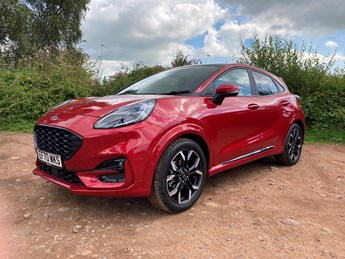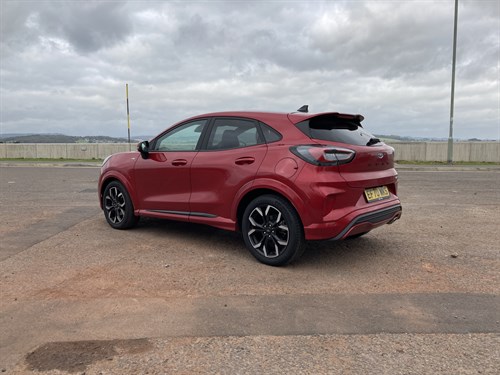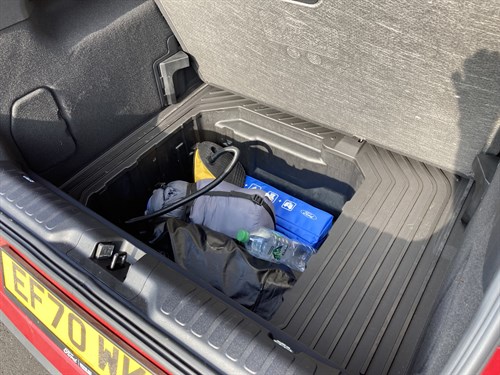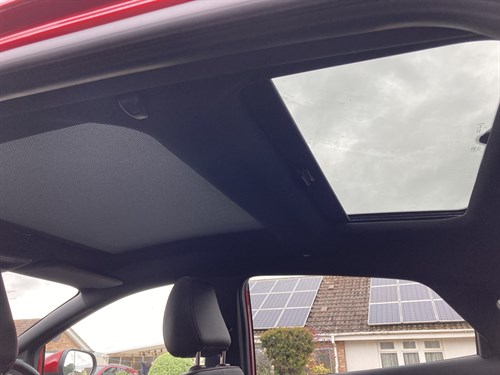We use cookies to ensure that we give you the best experience on our website. If you continue without changing your settings, we will assume that you are happy to receive all cookies on the Business Car website. However, if you would like to, you can change your cookies at any time

The start point for the best source of fleet information |
Final report: Ford Puma long-term test
Date: 29 November 2021 | Author: Sean Keywood

|
|
||||||||||||
Final Report: Still a winner
After three months and with just over 2,500 miles driven, our Ford Puma has now left our fleet. It joined us with a big reputation, and I'm happy to report that it's mostly delivered.
With mileage a bit limited due both to the short duration of the loan, and the fact I, like so many others, no longer have a regular office commute, most of its deployment has come on long motorway trips and short shopping runs. It's proved its worth during both, with its adaptive cruise control and satnav impressing on the motorway (though I'd have liked an automatic gearbox for the occasional M25 traffic jam), and its strong practicality coming to the fore the rest of the time, including with its large boot augmented by the under-floor Megabox feature. However, its confinement to these environments is still something of a shame, as it's when driven on B-roads that the Puma arguably shines the most, with driving dynamics that still put it at the top of the segment. It feels taut when cornering, and its willingness to change direction combined with sweet steering somehow makes it seem smaller than it is, while the mild hybrid engine provides a useful slug of power and torque, mated to a slick-shifting six-speed manual gearbox that impresses during enthusiastic driving. The three-cylinder engine also offers a fun burbling sound, like a mini V8, though it is perhaps a bit louder in the cabin than might be expected during regular use.

When it comes to running costs, having started very impressively, average mpg did dip during the course of our test to finish fractionally below the official WLTP figure - although a final result of 50.5mpg is still perfectly respectable.
Major faults were absent, with minor annoyances limited to the automatic wipers being a bit dozy sometimes in responding to rain - though that also goes for most similar systems I've tested - and the odd annoying buzz in the cabin.
Overall, the impression the Puma has made during our test has been very good. It's done nothing to make me question our choice of the model as New Company Car of the Year at the previous year's Business Car Awards, or indeed its retention of Compact SUV honours this time around, with its blend of driving dynamics, practicality and economy a formidable combo for rivals to match. All that being said, I haven't found myself enjoying my time with our car quite as much as I'd expected to, which I suspect may be due to personal taste rather than any great failing on its part. Equipment grades like our car's ST-Line X spec, with features such as firmer sports suspension and 18in alloy wheels, seem to me a bit of a frustrating halfway house, where I'd prefer either a more comfort-focused spec with a softer ride and an automatic gearbox, or a full-on performance model like the 200hp Puma ST. However, the popularity of grades such as ST-Line X among buyers, drawn to the aesthetic appeal of their sporty design features without the associated costs of a high-performance engine, would suggest I'm in the minority.
3rd Report: Boxing clever
Having written in past month about how the Puma got on when I attended a friend's stag do, it makes sense to start this month talking about the wedding itself. Held on the bride's family's farm, the overnight accommodation was camping, meaning the Puma had to take tents and bedding in addition to the usual posh wedding clothes and other supplies (it was BYOB) for myself and two friends.
Fortunately for us, when it comes to luggage space the Puma is a class leader among small SUVs, thanks in main to what Ford calls the Megabox. An area under the main boot floor (which can also be raised or lowered to provide either a flat loading lip or extra room), which might otherwise have housed a spare wheel, instead provides a separate luggage area. It's drainable, so would be of particular benefit to outdoorsy types needing to transport wetsuits and the like, but for our trip it did a fine job, as you can see from the picture, accommodating a tent and some extra camping gear, meaning the only luggage that needed to travel on the back seat was some soft bedding - far from shabby for a car based on the Fiesta supermini.

The drive to the wedding venue in south-east Cornwall also provided a chance for the Puma's satnav system to impress. Before setting off, I was concerned that it wanted to take us through Plymouth and across the Tamar Bridge as normal, while my smartphone's map software recommended a major diversion around the top of Dartmoor due to huge delays. Sceptical of the latter route, though still a bit fearful, I followed the car's choice, and it proved correct, as although the other side of the road coming out of Cornwall looked heavily congested, we sailed in without any holdups at all. One-up for Ford against the Silicon Valley tech giants then.
Weddings aside, the Puma has settled into more regular long-termer duties, taking me around southern and central England covering car launch events for Business Car, which have returned far more regularly since the lifting of Covid-19 lockdown restrictions. It's handled motorway duties well - the adaptive cruise control system may be slightly less subtle in applying the brakes than with other systems I've tried, such as that in my previous long-term Audi A3, but it's still a major stress saver overall on those long trips. While, despite the sports suspension with our ST-Line X car firming the ride up a bit, it's still nowhere near uncomfortable, meaning I generally arrive at my destination feeling fresh.
Another thing in our Puma's favour currently is how well it's performing from a fuel efficiency point of view (especially welcome given the widespread queues at petrol stations at the time of writing). It's currently achieving a real-world economy average of 55.4mpg - a decent amount ahead of the official 51.4mpg figure quoted from the WLTP cycle. So, while our car's mild hybrid powertrain, with a 48V motor that assists the petrol engine when accelerating and allows the stop-start system to cut in earlier when coming to a halt, might seem like small beans compared with full hybrid systems available with some rivals, it's proving frugal for us so far.
2nd Report: All aboard
While Business Car contributors with families have obvious, regular opportunities for testing the practicality levels of long-term test cars when they are fully loaded, those of us without often have to improvise. It was fortunate, therefore, that a recent opportunity arose to fill the Puma with passengers, in the form of a friend's stag do, for which I assumed responsibility for driving to and from the planned (daytime, non-alcohol related) activities.
So, what were the observations of back seat passengers that I'd previously missed? Well, aside from three adult men being able to fit back there in reasonable comfort, they liked the panoramic roof, which I hadn't noticed before is divided into two sections, meaning those in the rear can pull back the blind and let light in, without disturbing those sitting up front (i.e. me) who might prefer less light coming from above to help them concentrate on the road (although only the front section can be opened).

On the downside, they noticed a lack of grab handles back there, the provision of which might have made things a tad more comfortable as we bounced around on the heavily rutted lane to and from our campsite. From my point of view, having previously dismissed the instrument panel seat belt indicator, which appears on start-up, as a trivial annoyance, I realised how useful it was to have visual confirmation that everyone was strapped in before we set off, removing the need to ask - welcome enough for saving stag do cool points, never mind how helpful I imagine such a system must be for parents with kids in the back.
The hilly roads of Dorset did, however, reveal an apparent issue with the Puma, where having waited on an incline I found myself rolling backwards a couple of times when I tried to set off. Confused at having apparently forgotten how to drive, I ended up overcompensating and setting off with learner-style, needlessly high engine revs for the rest of the trip, until I could investigate what was going on. It turns out that the hill hold assist system, which I knew the car was fitted with, is governed by the footbrake, and will only apply for five seconds if the car is being held by the (manual) handbrake, meaning that if the car has been stationary for more than a moment, such as when waiting for a queue of traffic to pass on a narrow lane, the old art of proper clutch control is required when setting off again, rather than relying on the electronic helper. Although this did catch me out at the time, I'm more willing now to attribute the situation to my being spoiled by the electric handbrakes and automatic gearboxes that the majority of press test cars come with these days.
1st Report: In the red corner, the reigning champion...
When Ford introduced its new Puma, I was the first member of the Business Car team to drive it, having been lucky enough to attend the car's international launch in Spain over two days in January 2020. For very obvious reasons, that now seems like a very long time ago, but I do remember coming away highly impressed with a model that combined clever practical touches with being the best small SUV to drive on the market. It's an impression that was subsequently supported by my fellow judges for last year's Business Car Awards, where it picked up the overall New Company Car of the Year accolade. However, with the passing of time and the very different world in which we find ourselves now, it seems worth revisiting the model, to see if those extremely strong first impressions still endure now the glow of the initial launch has worn off - and also, having personally not driving the car in the UK before, to see if our rough home-grown road surfaces will reveal any flaws I missed in the Spanish sunshine.
To find out, we've added the car here to our long-term fleet, in attractive (if unsubtly named) Fantastic Red paint. It's an ST-Line X model, meaning it sits near the top of the range and gets equipment such as a 12.3in driver display, a ten-speaker B&O premium audio system, a wireless charging pad, and 18in alloy wheels. In addition, the ST-Line designation means it sits towards the sportier end of Ford's model line-up, and features elements such as a bodykit (including what Ford specifically bills as a 'large rear spoiler'), and also sports suspension. The latter feature in particular is one I'm keen to investigate, since while I already know the Puma is good in the bends, UK roads might leave it more susceptible to any related compromise in ride quality.
Our Puma comes with the most powerful engine option in the range short of the full ST performance model, a 155hp petrol mild hybrid, with the electrified system using a 48V battery to assist with acceleration and help reduce CO2 emissions. In our car, the engine is paired with a six-speed manual gearbox, rather than the seven-speed auto that's also available. The stick-shift should make for a more engaging drive, however it remains to be seen if I'll end up missing an auto on long journeys, especially since the manual means there's no stop-and-go function with the adaptive cruise control fitted as part of our car's optional Driver Assistance Pack.
One thing is for sure - with lockdown restrictions eased, and business and social travel diaries filling up rapidly, our Puma is sure to be covering plenty of miles over the next few months, meaning there'll be no hiding any weaknesses. However, having won us over so thoroughly at launch, it would be a major surprise if we uncovered many flaws.
Standard equipment:
18in alloy wheels, carbon-look interior trim, ST-Line body kit, sports suspension, LED DRLs and tail lights, front fog lights with cornering lights, automatic headlights with auto high-beam, rain-sensing wipers, power-foldable heated door mirrors with puddle lamps, flat-bottomed leather steering wheel, leather handbrake, aluminium gear knob, alloy pedals, lane keep assist, lane departure warning, autonomous emergency braking with pedestrian and cyclist detection and post-collision braking, wireless charging pad, 12.3in digital instrument cluster, sat-nav, ten-speaker B&O premium audio system, heated windscreen, privacy glass, hill start assist, electronic automatic temperature control, cruise control, selectable drive modes, rear parking sensors, driver and front passenger seat lumbar and height adjustment, tyre pressure monitoring system.
Options:
Fantastic Red exterior paint (£775); fixed LED headlights (£700); openable panoramic roof (£950); Driver Assistance Pack including autonomous emergency braking by radar and camera, blind spot information system with cross-traffic alert and active braking, intelligent adaptive cruise control with evasive steering, active park assist, front parking sensors, rear-view camera (£900).











